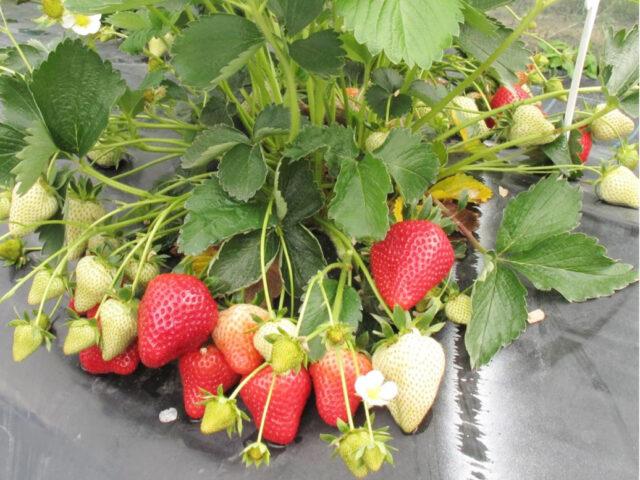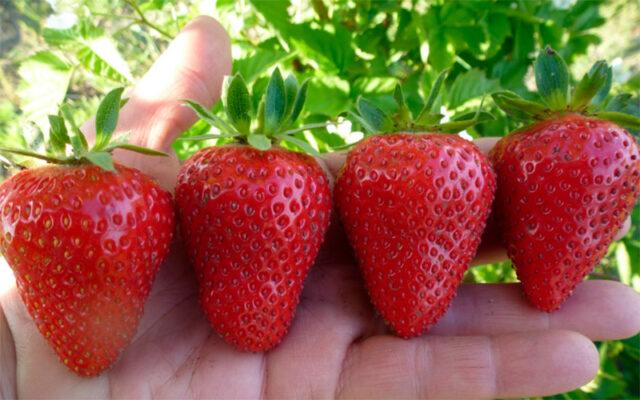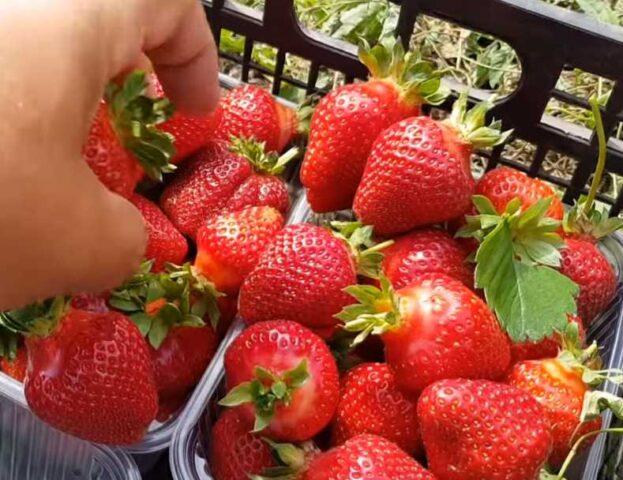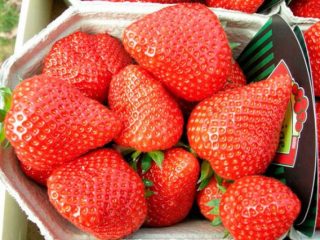Content
Aprica strawberry is a wonderful crop variety bred by foreign breeders. The variety has a lot of advantages with minor flaws, has proven itself both abroad and in Russia. The plant is hardy, tolerates winter well, practically does not get sick, is able to withstand heat and precipitation. In recent years, the variety has become very popular among gardeners.

Aprica is considered one of the hardiest strawberry varieties.
Breeding history
A variety of culture was introduced to the world relatively recently. It was bred in Italy by the Nursery Consortium (C.I.V.). According to the originators, Aprica strawberry is suitable for cultivation in continental climates, it can be cultivated in greenhouses, greenhouses, open field, it is suitable for hydroponics and small volumes. You can buy seedlings through Mazzoni or Salvi vivai.
Description of the Aprica strawberry variety and characteristics
A promising non-remontant variety of garden strawberries Aprica has an early ripening period. The use of fruits is universal, berries are suitable for fresh consumption, canning and freezing. The plant fell in love with gardeners and farmers for its generous harvest, the ability to withstand adverse weather conditions, diseases and pests. Strawberries are not demanding on the composition of the soil, they can tolerate both frost and drought. The crop is not baked in the sun, it can easily endure the heat. The variety is not sensitive to cold snaps and rainy weather, excess moisture does not cause rotting and does not spoil the taste.
Aprica strawberry bushes are small in size, medium spreading, spherical in shape, with upright large dark green leaves. Peduncles are not very large, but powerful, flowers are small, with an average amount of pollen, located below the level of the leaves. The pollination of the variety is remarkable, there are always a lot of fruits tied. The number of whiskers is moderate, which greatly facilitates the procedure for caring for the beds. Berries of the variety are smooth and beautiful, large, have a sweet taste, but without a "zest", nothing special.
Aprica strawberries do not need excessive attention, constant feeding and processing. More suitable for outdoor cultivation. When cultivated in a greenhouse, the potential of the variety is noticeably reduced.
Characteristics of fruits, taste
The Aprica strawberry bears fruit with large, one-dimensional berries. Their shape is standard - conical, sometimes there are double, very large specimens. The color of the fruit is bright red, with a glossy sheen, does not fade during storage. Achenes are small, not deep, their color is yellow. The weight of each berry is above average, about 30 g, and is maintained throughout the entire harvesting period. The pulp of the fruit has a dense structure, not firm, juicy, has a delicate aroma and sweet taste with subtle hints of acid. Taste qualities of strawberries, according to experts, from 4.3 to 5 points out of nine, do not deteriorate even with excessive humidity and lack of light. The Aprica strawberry has an excellent presentation, the berries are very beautiful.The fruits are not only good fresh, but also suitable for processing, safely tolerate freezing and do not lose their shape when thawed, they are used to make jam, jam and compote.

Aprica strawberries can be eaten fresh and used for preparations
Ripening terms, yield and keeping quality
Aprica is a self-pollinated variety. The ripening time directly depends on the climatic conditions and the region of cultivation, but roughly the berries begin to sing by the end of May. Sources classify strawberries as medium early varieties, although early harvests are several days ahead of some early varieties. The harvest period lasts from late spring to mid-summer. Aprica shows a good yield, about 1200 kg from one mature bush. Productivity is stable, regardless of weather conditions. The berries are good keeping quality, 7 points out of nine possible for storage. The crop can be freely transported over long distances, the fruits do not flow or wrinkle during transportation, while maintaining a wonderful appearance.

The variety is ideal for growing for sale
Growing regions, frost resistance
Aprica is suitable for cities with a continental climate; it can be cultivated in the Moscow region, the Middle Volga region, in the Urals and in the south of the country. At low temperatures, it requires 700 hours of rest. The variety tolerates winter well. In the southern regions, it does not require shelter. In areas where the temperature can drop below -10 degrees, the bushes should be mulched in autumn, dry leaves or sawdust are perfect for this.
Disease and pest resistance
The Aprica strawberry variety shows a high immunity to the development of diseases of the aerial part of the bushes and their root system. With proper care and choosing a place for planting, the plant is not afraid of such popular ailments as powdery mildew, rot or spotting. It is also not often damaged by pests, but garlic, lemon balm or marigolds can be planted around the bushes as a preventive measure.
Advantages and disadvantages of the variety
Strawberry Aprica, due to the large number of advantages, claims to be the leader among all similar varieties of culture. No variety can match her in characteristics.

The variety is at the testing stage and has not yet had time to show negative qualities
Advantages:
- high taste characteristics;
- large-fruited;
- good transportability;
- yield;
- one-dimensional shape of the fruit;
- resistance to high humidity;
- productivity;
- drought resistance;
- self-pollination;
- high immunity;
- frost resistance;
- moderate tempering;
- unpretentiousness to the soil.
Disadvantages:
- high price for seedlings;
- shortage in stores.
Reproduction methods
The most affordable way that will help in the shortest possible time to breed Aprica strawberries on the site is mustache reproduction. The greatest effect is given by shoots of two years of age. The strongest are the sockets that are closer to the mother bush. Experienced gardeners advise placing containers with nutrient soil under each of them in order to get the best quality seedlings with a closed root system.

You can plant seedlings with closed roots all year round.
Planting and leaving
Judging by the description, photos and reviews of gardeners, the Aprica strawberry variety is not particularly demanding to care for, but if the recommended agricultural practices are followed, the bushes show the best results. In order for the harvest to be good and the plant to be strong, simple requirements should be followed:
- The culture is planted in spring or summer, so that by autumn the plants will get stronger and safely survive the winter. An ideal place for strawberries would be a sunny, well-drained area with soil of neutral acidity, rich in humus. The occurrence of groundwater must be at least 1 m.Planting is carried out in a tape or bush method, adhering to an interval between shoots of about 30 cm.Attention! The root collar of the plant should not be deeply sunk into the soil.
- Strawberries are watered daily in the first half month after planting, then the frequency of humidification is reduced. The procedure is performed every 3-4 days from the beginning of the growing season until the moment of shelter. It is better if irrigation is carried out by a drip irrigation system.
- The beds must be loosened and freed from weeds without fail or mulched with agrofibre, straw.
- Aprica is fed three or four times a year. In spring, diluted mullein or chicken droppings are suitable for this, during the formation of ovaries - nitrophoska or potassium salt, at the time of fruiting - wood ash.
Preparing for winter
Aprica showed good frost resistance with a small cover. Judging by the reviews of experienced gardeners, this variety of strawberries is able to safely survive the winter not only in the Volga region, but also in the Urals. It is enough just to insulate the bushes with a five-centimeter layer of mulch: straw, leaves, sawdust. In the conditions of the Krasnodar and Stavropol Territories, in the North Caucasus, the need for shelter disappears.

In the southern regions, Aprica does not need winter preparation
Conclusion
Aprica strawberries are considered a bright addition to the range of early-maturing varieties of culture. The variety is great for both amateur gardeners and farmers. The variety has practically no flaws, except for problems in acquisition. Planting material is difficult to buy, and its cost is still very high. The rest of the variety is wonderful: it ripens early, brings an excellent harvest, has a beautiful presentation and excellent taste.
Reviews of gardeners about Aprica strawberries
Svitich Konstantin, 50 years old, Shatsk
A couple of years ago, a friend from Italy brought me Aprica strawberries for seedlings. The first year the bushes were sick, there were practically no berries, but the next season the result was much better. The fruits were smooth, beautiful, tastes good, about two buckets were collected from a dozen bushes. I will see how the species behaves next year. I hope it doesn't disappoint.








